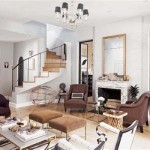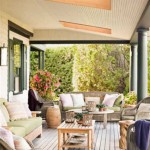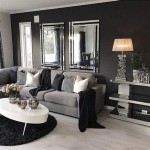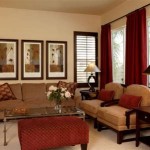Mirror In Living Room Decor
Mirrors offer significant potential for enhancing living room decor. Beyond their practical function of reflection, they serve as versatile design elements capable of manipulating light, creating illusions of space, and adding a touch of elegance to any interior. Understanding how to effectively incorporate mirrors into a living room design scheme can significantly impact the overall aesthetic and atmosphere.
One primary benefit of incorporating mirrors in living room decor is their ability to amplify natural light. Strategically positioning a mirror opposite a window can effectively bounce sunlight deeper into the room, brightening dark corners and creating a more welcoming ambiance. This is particularly advantageous in smaller living rooms or those with limited natural light sources. The reflective surface maximizes the available light, making the space feel more open and airy.
Mirrors can also create the illusion of expanded space. Placing a large mirror on a wall can visually double the size of a room. This effect is most pronounced when the mirror reflects a visually appealing area or a light source. The reflection creates a sense of depth and expansiveness, making the room feel less confined. Designers often utilize this technique in smaller living rooms or hallways to maximize the perceived square footage.
Beyond their practical functions, mirrors contribute significantly to the overall aesthetic of a living room. Decorative mirrors are available in a vast array of styles, frames, and sizes, offering homeowners a wealth of options to complement their existing decor. From ornate, antique-style mirrors to sleek, modern designs, the right mirror can serve as a focal point or a subtle accent piece, elevating the overall design scheme.
The choice of mirror frame plays a crucial role in its integration with the overall decor. For instance, a metallic frame, such as gold or silver, can introduce a touch of glamour and sophistication, while a wooden frame might complement a more rustic or traditional interior. Similarly, a frameless mirror offers a minimalist aesthetic, ideal for contemporary living spaces. Careful consideration of frame style ensures the mirror harmonizes with the existing furniture, color palette, and overall design theme.
Mirror placement is a critical factor in maximizing their impact on the living room. While placing a mirror opposite a window maximizes light reflection, positioning it to reflect a piece of art or an attractive architectural feature can create a visually engaging focal point. Alternatively, a series of smaller mirrors arranged in a gallery wall format can add a touch of personality and visual interest.
Shape and size are also crucial considerations. Large, rectangular mirrors are excellent for creating the illusion of height and space, while smaller, round or oval mirrors can serve as decorative accents. Oversized mirrors, leaning against a wall, have also become a popular design trend, adding a casual yet stylish touch to the living room. Choosing the right size and shape depends on the specific dimensions of the room and the desired aesthetic effect.
Integrating mirrors with other decorative elements is key to achieving a cohesive design. For example, a mirror positioned above a fireplace mantel can create a striking focal point, while a mirror placed behind a console table can add depth and visual interest. Layering mirrors with other decorative elements, such as artwork, plants, or decorative objects, can further enhance their impact and create a more dynamic visual composition.
Maintaining a balance is crucial when incorporating mirrors into living room decor. While strategically placed mirrors can enhance the space, excessive use can create a cluttered and disorienting effect. Carefully considered placement and thoughtful selection of size and style are essential to ensure the mirrors contribute positively to the overall aesthetic.
Different types of mirrors can cater to different design preferences and functional needs. Full-length mirrors are practical for checking one’s appearance and can also contribute to the illusion of height. Convex mirrors offer a wider field of view and can add a unique decorative touch. Concave mirrors, on the other hand, create a distorted reflection, often used as a decorative element in more eclectic or whimsical interiors.
The style of the living room should heavily influence the choice of mirror. A minimalist living room might benefit from a sleek, frameless mirror, while a more traditional space might be complemented by an ornate, antique-style mirror. Matching the mirror's style to the overall design scheme ensures a cohesive and harmonious aesthetic.
Regular cleaning and maintenance are essential to preserve the reflective quality and aesthetic appeal of mirrors. Dust and fingerprints can significantly diminish their effectiveness, so regular cleaning with a suitable glass cleaner is recommended. Proper care ensures the mirrors continue to enhance the living room's decor for years to come.
Ultimately, mirrors offer a versatile and cost-effective way to elevate living room decor. By carefully considering factors such as size, shape, placement, and frame style, homeowners can harness the power of reflection to create a more luminous, spacious, and stylish living environment.

How To Decorate With Mirrors Decorating Ideas For

5 Easy Ways Living Room Mirrors Can Amp Up Your Space

Mirror Decoration Ideas For Living Room Doğtaş

10 Impressive Oversized Mirrors To Make Any Room Feel Bigger Large Mirror Living Wall

How To Decorate Your Living Room With Mirrors Beautiful Homes

5 Easy Ways Living Room Mirrors Can Amp Up Your Space

28 Unique And Stunning Wall Mirror Designs For Living Room Mirrors Decor

5 Decorative Wall Mirrors For Your Home Designcafe

Mirror Decoration For Home 15 Ideas To Decorate With Mirrors

How To Decorate With Mirrors Decorating Ideas For
Related Posts







